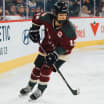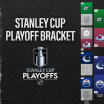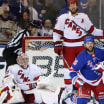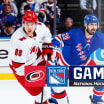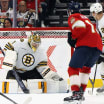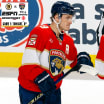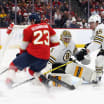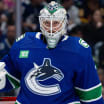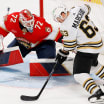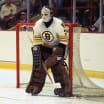O'Ree's election to Hall of Fame is honor that eluded boyhood idols
Pioneering all-black line of Carnegie brothers, McIntyre excelled after World War II
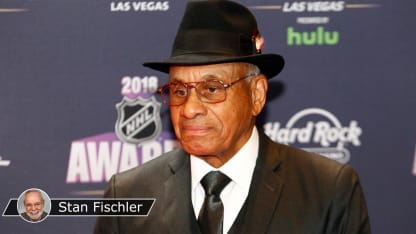
I saw Willie play from his first game with the Boston Bruins on Jan. 18, 1958, when he became the first black player to play in the NHL, until he hung up his skates for good in 1979 after playing 45 NHL games as well as more than 1,000 in the minor leagues, most of them with Los Angeles and San Diego in the Western Hockey League.
I've also had the pleasure of interviewing him several times, as well as hosting him at my apartment, where we spent most of the time talking hockey. On one occasion, I mentioned that I'm a Brooklyn native and had seen Jackie Robinson play numerous times for the Dodgers at Ebbets Field. Then I asked if he knew anything about the following names: Herb Carnegie, Ossie Carnegie and Manny McIntyre.
His eyes lit up.
"Are you kidding me?" he shot back. "These guys were like my idols. I must have been about 12 at the time that they were considered one of the best lines in North America."
What Willie didn't say because he didn't have to was that the Carnegies and McIntyre comprised an all-African-Canadian forward line -- the first of its kind at that level. At their peak during the years immediately following World War II, they were the talk of minor league hockey.
"They were fantastic," O'Ree said. "One of the best lines you can imagine."
He didn't have to tell me because I had seen them play -- Herb Carnegie at center, older brother Ossie on the right and McIntyre on the left at Madison Square Garden during the 1948-49 season. They starred for the Sherbrooke Red Raiders, then a member of the Quebec Senior Hockey League. The date was Feb. 27, 1949.
O'Ree said the Carnegies and McIntyre had a powerful impact on him and other African-Canadian players at the time.
Larry Zeidel, a Stanley Cup-winning defenseman with the Detroit Red Wings in 1952 whose pro career lasted into the late 1960s, remembered playing against the line before making it to the NHL.
"They would have been good enough to star in the NHL," Zeidel said. "But in those days the NHL was a six-team league and, believe it or not, they could make as much [money] in the minors as in the NHL."
Richard Wilson, who covered the team for the Sherbrooke Daily Record, waxed ecstatic talking about them.
"Herbie Carnegie, who centered the line, was as good as any hockey player around," he wrote. "He had all the standard moves and a couple of his own specialties. He excelled in all departments, stickhandling, passing, playmaking, shooting, forechecking, backchecking, penalty-killing, and speed.
"Ossie was stronger physically than the other two, with a blazing shot and terrific in the corners. Manny was a fine positional left wing. Bigger than the brothers, Manny would mix it up with any challenger. As a line, they always were in tune; call it three-part harmony."
According to Zeidel, the Carnegies and McIntyre faced no hostility in Quebec because of their skin color.
"When Herbie played for the Quebec Aces, he was accepted as an equal," he said. "There was no such thing as separate quarters because he was black. Except for the color of his skin, you'd never know that Carnegie was any different from the rest of us."
But though Zeidel may not have witnessed any hostility toward the Carnegie brothers or McIntyre, that view may have been the exception to what really took place.
In his autobiography, "A Fly in a Pail of Milk: The Herb Carnegie Story," he wrote that fans and opposing coaches insulted him and other black players throughout his amateur and semipro career. Carnegie cried openly about it during an interview with CBC in 2009.
Like O'Ree, Hockey Hall of Famer Jean Beliveau idolized the three -- especially Herb Carnegie, later a teammate with Quebec in the QSHL. "I never missed a game when Sherbrooke was in town," Beliveau once said. "I tried to duplicate what Herbie was doing with face-offs and making passes onto the blade, not behind the wingman."
Wilson described one of Herb's goals as follows: "With four seconds to go in the second period, Herbie took the puck from Manny at the blue line, wormed his way through the defense with a beautiful display of stickhandling, drew the goalie out of position and slammed a shot past him that never left the ice."
The line remained intact through the late 1940s. Herb Carnegie continued his career with the Aces in the QSHL, arguably the best league outside the NHL at the time. They were coached by Punch Imlach, who would guide the Toronto Maple Leafs to four Stanley Cup championships in the 1960s.
The New York Rangers gave Herb Carnegie a tryout at training camp in 1948, though it received virtually no attention in the New York papers at the time.
In The New York Times obituary for Carnegie, who died at 92 on March 9, 2012, he described the tryout by saying, "It was a very exciting time for me -- my opportunity."
Carnegie said he was offered a contract with Tacoma in the low-level Pacific Coast Hockey League but rejected it. The Rangers then offered to have him play for a higher-level team --- St. Paul in the United States Hockey League -- but again he turned down the offer. General manager Frank Boucher finally upped the ante with an offer to skate for New Haven of the American Hockey League, a Rangers farm team that was one rung below the NHL.
But like Beliveau, who remained with the Aces for two seasons during the early 1950s before signing with the Canadiens, Carnegie turned down that offer from the Rangers. As was the case with Beliveau, he could make more money skating in the Quebec league than in the NHL.
Carnegie was 34 when he retired in 1954. One year later, he opened the Future Aces Hockey School, one of the first hockey schools in Canada. He also had great success as a businessman and a golfer, and was named to the Order of Canada, the country's highest civilian award, in 2003. But his role as player and pioneer has yet to earn him a place in the Hockey Hall of Fame. In the early 2000s, an attempt was made to have him elected; however, the Selection Committee did not choose him as a player or a builder.
O'Ree, 82, has spent the past 20 years working as the NHL's Diversity Ambassador for the Hockey Is For Everyone initiative. He's become a hero and role model for new generations, the way Herb Carnegie and his linemates were to him.


